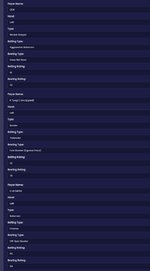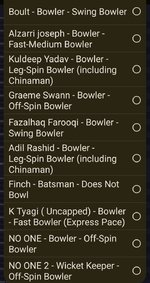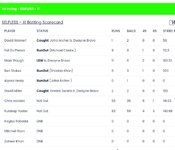Any new updates coming this week?There is no limit.
You are using an out of date browser. It may not display this or other websites correctly.
Build Street Cricket Simulator - Stadium, Player and Team Creator Out!
- Thread starter WubbaLubbaDubDub
- Start date
To be used when developing an addon/patch/app etc
- Status
- Not open for further replies.
Nothing this or next week. I am traveling to India this week so will be busy with all family things.Any new updates coming this week?
HotShots
School Cricketer
- Joined
- Dec 24, 2023
- Profile Flag
- India
Nothing this or next week. I am traveling to India this week so will be busy with all family things.
As You Can See There are QDK and HETMYER In The Team But During Team Selection I can't See their Names
Help
Attachments
I ll take a look at it todayAs You Can See There are QDK and HETMYER In The Team But During Team Selection I can't See their Names
Help
HotShots
School Cricketer
- Joined
- Dec 24, 2023
- Profile Flag
- India
@ShamiLoverGlipGlops
I Have Some Concern over Pitches Like Damp, Wet and Grass.
Always Produced Scorecard Like These
I am Simming A Tournament , Solve these Problems

I Have Some Concern over Pitches Like Damp, Wet and Grass.
Always Produced Scorecard Like These
I am Simming A Tournament , Solve these Problems


Attachments
Last edited by a moderator:
Pollard opening the bowling while Jimmy is third change...
HotShots
School Cricketer
- Joined
- Dec 24, 2023
- Profile Flag
- India
@ShamiLoverGlipGlops Are You Here?
ignore this if this has been pointed out before, but can I not create a team without filling out the 20 players? For example, if I want to make a team with 18 players? @ShamiLoverGlipGlops
Be back here in few more days. In India right now and spending time with family plus working night shifts (US time). Have had no time to be here on PC.
HotShots
School Cricketer
- Joined
- Dec 24, 2023
- Profile Flag
- India
Say no more fam
Update - 05/14
I just want to say to those who have supported this development all along a BIG THANK YOU. Without the support and motivation there is no SCS. I have not stopped working on this and whenever and wherever I could, I would think on improving this.
I would like to say no body is perfect and that includes me at 1st position. What started out as a project for myself and only a Street Cricket Simulator soon became a big thing with T20 and T10.
I have been struggling off late with time management. Those of who know, I have a dog who was detected with cancer, along with handling him and his needs like all managing full time job has been a tough ask. In between obviously you cannot forget to live your life.
All personal things apart, I have a little update and future roadmap for this project. I do not know if this is exciting, boring or just meh not interesting but I would like to share.
Over the last 3 months, I have completely re-written the ball simulation engine. The current tech stack it uses is PHP and I wrote the newer engine in Python. Along with new ball simulation engine, I have also rewritten something that most do not pay attention and that is toss - a crucial part of a cricket game.
So having said the above, here is what has been written and now is in test mode.
Response returned back
If anyone wants to test the API directly, please let me know by messaging me. I would prefer tech friendly people only since this is directly testing API using Postman or other tools.
Thank you
I just want to say to those who have supported this development all along a BIG THANK YOU. Without the support and motivation there is no SCS. I have not stopped working on this and whenever and wherever I could, I would think on improving this.
I would like to say no body is perfect and that includes me at 1st position. What started out as a project for myself and only a Street Cricket Simulator soon became a big thing with T20 and T10.
I have been struggling off late with time management. Those of who know, I have a dog who was detected with cancer, along with handling him and his needs like all managing full time job has been a tough ask. In between obviously you cannot forget to live your life.
All personal things apart, I have a little update and future roadmap for this project. I do not know if this is exciting, boring or just meh not interesting but I would like to share.
Over the last 3 months, I have completely re-written the ball simulation engine. The current tech stack it uses is PHP and I wrote the newer engine in Python. Along with new ball simulation engine, I have also rewritten something that most do not pay attention and that is toss - a crucial part of a cricket game.
So having said the above, here is what has been written and now is in test mode.
- Both toss and a simulation of a single delivery would now be served via a Rest API.
- I have created API's for both using Flask.
- The reason I did this is so that I can still reuse the same GUI and just change the backend.
1. Simulating Toss - API
JSON:
{
"team1": "Team A",
"team2": "Team B",
"team1_strength": "Batting",
"team2_strength": "Bowling",
"boundaries": "Short",
"dew_factor": "Yes",
"pitch_condition": "Grass",
"weather_condition": "Sunny"
}Response returned back
JSON:
{
"TossCalled": "Heads",
"TossCommentary": "Team A called for Heads and won! Team A has elected to bat first . They considered that the dew factor making bowling tricky. This decision could prove vital in today's game.",
"TossDecision": "Bat First",
"TossLost": "Team B",
"TossWon": "Team A"
}Toss Factors Explained
Team Strength
- Batting: Indicates the team is stronger in batting.
- Bowling: Indicates the team is stronger in bowling.
- All Round: Indicates the team is balanced in both batting and bowling.
Boundaries
- Short: Short boundary lengths favoring aggressive batting.
- Medium: Medium boundary lengths providing a balanced game.
- Long: Long boundary lengths favoring bowlers.
Dew Factor
- Yes: Presence of dew, which can make bowling tricky due to a slippery ball.
- No: No dew factor affecting the game.
Pitch Condition
- Grass: A green pitch that usually assists bowlers.
- Hard: A hard pitch favoring batsmen with consistent bounce.
- Damp: A damp pitch that can be unpredictable.
- Dusty: A dusty pitch that often assists spinners.
- Wet: A wet pitch that can be challenging for both batsmen and bowlers.
- Artificial: An artificial pitch with consistent behavior.
Weather Condition
- Sunny: Clear weather, usually favoring batsmen.
- Humid: Humid conditions that can affect swing bowling.
- Cloudy: Cloudy weather that can assist bowlers with swing.
- Overcast: Overcast conditions that typically favor bowlers.
2. Simulating Single Ball
JSON:
{
"ball_number": 1,
"batsman_rating": 80,
"batsman_fatigue": 20,
"pitch_conditions": "good",
"weather_conditions": "clear",
"chasing_target": false,
"bowler_rating": 75,
"bowler_fatigue": 10,
"inning_part": "PowerPlay",
"format_type": "T20",
"wickets_left": 5,
"deliveries_bowled": 10,
"bowler_name": "Starc",
"batsman_name": "Kohli",
"batsman_type": "Aggressive",
"bowler_type": "Wicket Taker",
"wind_conditions": "moderate",
"time_of_day": "day",
"batsman_hand": "Right",
"bowler_hand": "Left"
}
JSON:
{
"outcome": "single",
"runs": 1,
"wicket": false,
"wicket_type": null,
"commentary": "Ball 1: Starc to Kohli (single) Quick single taken."
}Simulation Factors Explained
1. Realistic Delivery Simulation
The API simulates a single cricket delivery by taking into account multiple parameters:- Batsman's Rating: A higher rating increases the chances of scoring runs.
- Batsman's Fatigue: Higher fatigue reduces the batsman's effectiveness.
- Bowler's Rating: A higher rating increases the chances of taking a wicket.
- Bowler's Fatigue: Higher fatigue reduces the bowler's effectiveness.
2. Match Context Consideration
The simulation adjusts probabilities based on match context:- Pitch Conditions: Good conditions favor the batsman, while poor conditions favor the bowler.
- Weather Conditions: Clear weather generally favors the batsman, while overcast conditions favor the bowler.
- Part of the Inning:Different phases (PowerPlay, Middle Overs, Death Overs) have distinct characteristics:
- PowerPlay: Higher chances of scoring due to fielding restrictions.
- Middle Overs: Balanced conditions where building an innings is crucial.
- Death Overs: Higher chances of scoring or getting out due to increased risk-taking.
- Format Type:Adjusts based on whether the match is T20, ODI, or Test:
- T20: High scoring and higher risk of getting out.
- ODI: Varies by phase with a balanced approach.
- Test: Lower scoring rates with a focus on batting long periods.
3. Player Types
The simulation considers different types of players:- Batsman Type:
- Aggressive: Higher chances of hitting boundaries and getting out.
- Defensive: Higher chances of playing dot balls and lower risk of getting out.
- Accumulator: Higher chances of singles and doubles.
- Tail Ender: Higher chances of getting out and lower chances of hitting boundaries.
- Bowler Type:
- Wicket Taker: Higher chances of taking wickets.
- Runs Holder: Higher chances of dot balls.
- PowerPlay Specialist: Better performance during PowerPlay.
- Death Over Specialist: Better performance during Death Overs.
- Economical: Lower run rates and higher dot balls.
4. Environmental Factors
- Wind Conditions:
- Windy: Higher chances of misses and edges.
- Moderate: Neutral effect.
- None: No wind effect.
- Time of Day:
- Day: Standard conditions.
- Day Night: Adjustments based on changing conditions.
- Night: Higher chances of wickets and dot balls.
5. Player Orientation
- Batsman Hand: Left or Right-handed batsman.
- Bowler Hand: Left or Right-handed bowler.
6. Additional Outcomes
The API can also return additional outcomes:- Wide: Extra run and re-bowled delivery.
- No Ball: Extra run, free hit on the next delivery.
- Leg Bye: Runs taken off the pad.
- Edge: Edged to the slips or keeper.
- Miss: Batsman swings and misses.
7. Dynamic Probability Adjustments
Probabilities are dynamically adjusted based on the input parameters:- Effective Ratings: Adjusted for fatigue to reflect the current performance level.
- Contextual Adjustments: Based on pitch, weather, inning phase, format, and match situation.
8. Commentary Generation
For each delivery, the API generates a random commentary line:- Commentary Lines: Predefined lines for different outcomes (dot, single, double, triple, four, six, wicket, wide, no ball, leg bye, edge, miss).
- Wicket Types: Specific lines for different wicket types (LBW, Bowled, Stumped, Run Out, Caught).
Future Road Map
- Integrate the new toss and ball simulation engine into existing application
- Move the hosting from AWS to something else (Not expensive as I am paying anywhere between $3-$5 a month)
- TEST TEST TEST
- Release
- PLEASE NOTE I do not have any fixed dates on when will this be implemented. I just wanted to provide an update.
If anyone wants to test the API directly, please let me know by messaging me. I would prefer tech friendly people only since this is directly testing API using Postman or other tools.
Thank you
Update - 05/14
I just want to say to those who have supported this development all along a BIG THANK YOU. Without the support and motivation there is no SCS. I have not stopped working on this and whenever and wherever I could, I would think on improving this.
I would like to say no body is perfect and that includes me at 1st position. What started out as a project for myself and only a Street Cricket Simulator soon became a big thing with T20 and T10.
I have been struggling off late with time management. Those of who know, I have a dog who was detected with cancer, along with handling him and his needs like all managing full time job has been a tough ask. In between obviously you cannot forget to live your life.
All personal things apart, I have a little update and future roadmap for this project. I do not know if this is exciting, boring or just meh not interesting but I would like to share.
Over the last 3 months, I have completely re-written the ball simulation engine. The current tech stack it uses is PHP and I wrote the newer engine in Python. Along with new ball simulation engine, I have also rewritten something that most do not pay attention and that is toss - a crucial part of a cricket game.
So having said the above, here is what has been written and now is in test mode.
- Both toss and a simulation of a single delivery would now be served via a Rest API.
- I have created API's for both using Flask.
- The reason I did this is so that I can still reuse the same GUI and just change the backend.
1. Simulating Toss - API
JSON:{ "team1": "Team A", "team2": "Team B", "team1_strength": "Batting", "team2_strength": "Bowling", "boundaries": "Short", "dew_factor": "Yes", "pitch_condition": "Grass", "weather_condition": "Sunny" }
Response returned back
JSON:{ "TossCalled": "Heads", "TossCommentary": "Team A called for Heads and won! Team A has elected to bat first . They considered that the dew factor making bowling tricky. This decision could prove vital in today's game.", "TossDecision": "Bat First", "TossLost": "Team B", "TossWon": "Team A" }Toss Factors Explained
Team Strength
- Batting: Indicates the team is stronger in batting.
- Bowling: Indicates the team is stronger in bowling.
- All Round: Indicates the team is balanced in both batting and bowling.
Boundaries
- Short: Short boundary lengths favoring aggressive batting.
- Medium: Medium boundary lengths providing a balanced game.
- Long: Long boundary lengths favoring bowlers.
Dew Factor
- Yes: Presence of dew, which can make bowling tricky due to a slippery ball.
- No: No dew factor affecting the game.
Pitch Condition
- Grass: A green pitch that usually assists bowlers.
- Hard: A hard pitch favoring batsmen with consistent bounce.
- Damp: A damp pitch that can be unpredictable.
- Dusty: A dusty pitch that often assists spinners.
- Wet: A wet pitch that can be challenging for both batsmen and bowlers.
- Artificial: An artificial pitch with consistent behavior.
Weather Condition
---------------------------------------------------------------------------
- Sunny: Clear weather, usually favoring batsmen.
- Humid: Humid conditions that can affect swing bowling.
- Cloudy: Cloudy weather that can assist bowlers with swing.
- Overcast: Overcast conditions that typically favor bowlers.
2. Simulating Single Ball
JSON:{ "ball_number": 1, "batsman_rating": 80, "batsman_fatigue": 20, "pitch_conditions": "good", "weather_conditions": "clear", "chasing_target": false, "bowler_rating": 75, "bowler_fatigue": 10, "inning_part": "PowerPlay", "format_type": "T20", "wickets_left": 5, "deliveries_bowled": 10, "bowler_name": "Starc", "batsman_name": "Kohli", "batsman_type": "Aggressive", "bowler_type": "Wicket Taker", "wind_conditions": "moderate", "time_of_day": "day", "batsman_hand": "Right", "bowler_hand": "Left" }
JSON:{ "outcome": "single", "runs": 1, "wicket": false, "wicket_type": null, "commentary": "Ball 1: Starc to Kohli (single) Quick single taken." }
Simulation Factors Explained
1. Realistic Delivery Simulation
The API simulates a single cricket delivery by taking into account multiple parameters:
- Batsman's Rating: A higher rating increases the chances of scoring runs.
- Batsman's Fatigue: Higher fatigue reduces the batsman's effectiveness.
- Bowler's Rating: A higher rating increases the chances of taking a wicket.
- Bowler's Fatigue: Higher fatigue reduces the bowler's effectiveness.
2. Match Context Consideration
The simulation adjusts probabilities based on match context:
- Pitch Conditions: Good conditions favor the batsman, while poor conditions favor the bowler.
- Weather Conditions: Clear weather generally favors the batsman, while overcast conditions favor the bowler.
- Part of the Inning:Different phases (PowerPlay, Middle Overs, Death Overs) have distinct characteristics:
- PowerPlay: Higher chances of scoring due to fielding restrictions.
- Middle Overs: Balanced conditions where building an innings is crucial.
- Death Overs: Higher chances of scoring or getting out due to increased risk-taking.
- Format Type:Adjusts based on whether the match is T20, ODI, or Test:
- T20: High scoring and higher risk of getting out.
- ODI: Varies by phase with a balanced approach.
- Test: Lower scoring rates with a focus on batting long periods.
3. Player Types
The simulation considers different types of players:
- Batsman Type:
- Aggressive: Higher chances of hitting boundaries and getting out.
- Defensive: Higher chances of playing dot balls and lower risk of getting out.
- Accumulator: Higher chances of singles and doubles.
- Tail Ender: Higher chances of getting out and lower chances of hitting boundaries.
- Bowler Type:
- Wicket Taker: Higher chances of taking wickets.
- Runs Holder: Higher chances of dot balls.
- PowerPlay Specialist: Better performance during PowerPlay.
- Death Over Specialist: Better performance during Death Overs.
- Economical: Lower run rates and higher dot balls.
4. Environmental Factors
- Wind Conditions:
- Windy: Higher chances of misses and edges.
- Moderate: Neutral effect.
- None: No wind effect.
- Time of Day:
- Day: Standard conditions.
- Day Night: Adjustments based on changing conditions.
- Night: Higher chances of wickets and dot balls.
5. Player Orientation
- Batsman Hand: Left or Right-handed batsman.
- Bowler Hand: Left or Right-handed bowler.
6. Additional Outcomes
The API can also return additional outcomes:
- Wide: Extra run and re-bowled delivery.
- No Ball: Extra run, free hit on the next delivery.
- Leg Bye: Runs taken off the pad.
- Edge: Edged to the slips or keeper.
- Miss: Batsman swings and misses.
7. Dynamic Probability Adjustments
Probabilities are dynamically adjusted based on the input parameters:
- Effective Ratings: Adjusted for fatigue to reflect the current performance level.
- Contextual Adjustments: Based on pitch, weather, inning phase, format, and match situation.
8. Commentary Generation
For each delivery, the API generates a random commentary line:
- Commentary Lines: Predefined lines for different outcomes (dot, single, double, triple, four, six, wicket, wide, no ball, leg bye, edge, miss).
- Wicket Types: Specific lines for different wicket types (LBW, Bowled, Stumped, Run Out, Caught).
Future Road Map
- Integrate the new toss and ball simulation engine into existing application
- Move the hosting from AWS to something else (Not expensive as I am paying anywhere between $3-$5 a month)
- TEST TEST TEST
- Release
- PLEASE NOTE I do not have any fixed dates on when will this be implemented. I just wanted to provide an update.
If anyone wants to test the API directly, please let me know by messaging me. I would prefer tech friendly people only since this is directly testing API using Postman or other tools.
Thank you

- Status
- Not open for further replies.
Similar threads
- Replies
- 8
- Views
- 4K
- Replies
- 50
- Views
- 9K
- Sticky
- Replies
- 23
- Views
- 5K
- Replies
- 12
- Views
- 2K
Users who are viewing this thread
Total: 4 (members: 0, guests: 4)




















